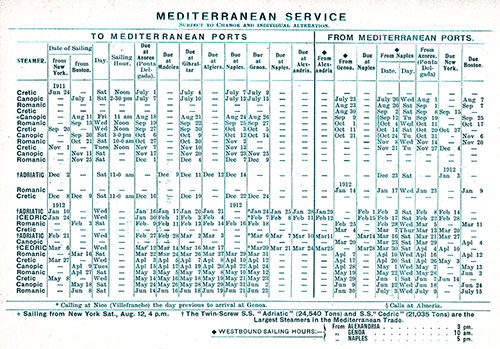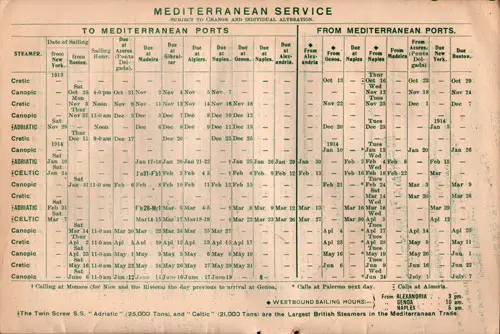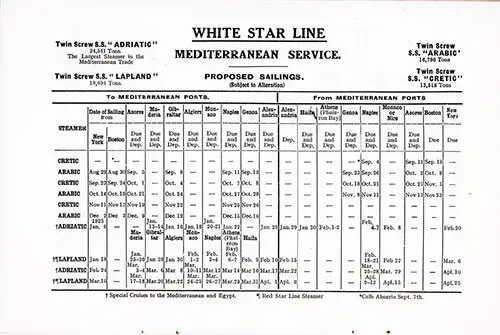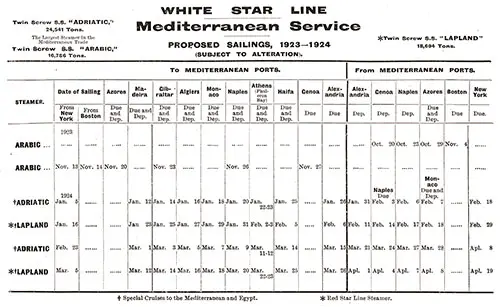RMS Adriatic Archival Collection
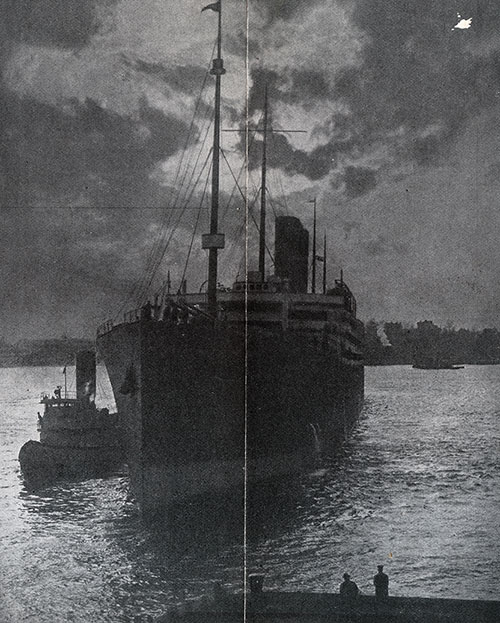
The RMS Adriatic off The White Star Piers at New York. The Famous Big 4 of the New York-Liverpool Service, 1909 Brochure. | GGA Image ID # 11aae42fb3
RMS Adriatic Content Links
- Adriatic (1906) White Star Line Ship's History (Brief)
- Passenger Lists
- Brochures
- Sailing Schedules
- Route Maps, Track Charts, Abstract of Logs
- Other Ephemera
- Books Referencing the RMS Adriatic
- Advertisements
- Excerpts from Information for Passengers
- Photographs
- Adriatic Successfully Launched - 1906
- The Ship of the Year: The RMS Adriatic - 1907
Adriatic (1906) White Star Line
Built by Harland & Wolff, Ltd., Belfast, Ireland. Tonnage: 24,563. Dimensions: 709' x 75' (726' o.l.). Twin-screw, 18 knots. Quadruple expansion engines. Four masts and two funnels. Launched: September 20, 1906. Maiden voyage: Liverpool-New York, May 8, 1907. A very steady and excellent type of passenger ship. Fate: Sold to Japanese ship-breakers in December 1934. Dismantled in Japan, 1935. Sister ship: Baltic. Note: The top superstructure differed considerably from the Baltic. However they were quite similar in other aspects. The general appearance also was similar to the Cedric and Celtic. The four liners comprised the White Star Line's "Big Four".
The Adriatic Sailed Between the Ports of New York, Liverpool, Southampton, Cherbourg, Queenstown (Cobh), Belfast, Glasgow, Syracuse, Naples, Monaco, and Gibraltar.
Return to Content Links
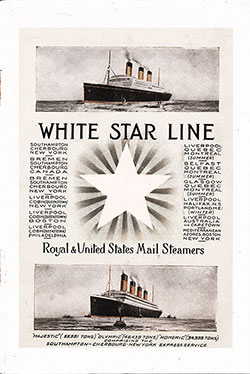
RMS Adriatic Passenger Lists 1919-1931
All Digitized Lists of Passengers for the RMS Adriatic Available at the GG Archives. Listing Includes Date Voyage Began, Steamship Line, Vessel, Passenger Class and Route.
Routes: New York to Liverpool; Southampton to New York via Cherbourg; New York to Southampton via Cherbourg; Liverpool to New York via Cobh; Alexandria to New York via Syracuse, Naples, Monaco, and Gibraltar; Liverpool to New York via Queenstown (Cobh); and Liverpool to New York via Belfast and Glasgow.
Return to Content Links

1909-04-16 The Famous Big 4 - New York-Liverpool Service
This 8-Page White Star Line brochure on the Famous Big 4 of the New York Liverpool Service - The Adriatic, Baltic, Cedric, and Celtic, is packed with incredible photographs (Interior and exterior) some with actual passengers. Includes information on the ships and their accommodations.

The Steamers of the White Star Line - 1909
A 1909 Brochure from the White Star Line is a Pictorial Featuring the Olympic and Titanic, Adriatic, Baltic, Canopic, Celtic, Laurentic and Megantic, Majestic and Teutonic, Romanic, Oceanic, Zeeland, and more.

1930 - White Star Line To Boston and New York in Third Class
Translated from a 1930 Dutch brochure on third-class accommodations on the "Big Four" - the Britannic, Baltic, Cedric, and Adriatic, with many interior photographs to document this class of travel in 1930.
Return to Content Links
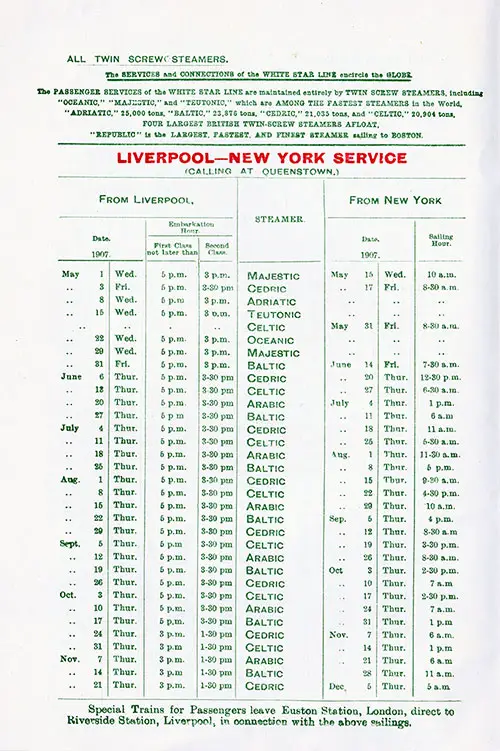
Sailing Schedule, Liverpool-New York Service, from 1 May 1907 to 6 December 1907. Ships Included the Adriatic, Arabic, Baltic, Cedric, Celtic, Majestic, Oceanic, and Teutonic. RMS Republic Passenger List, 14 August 1907. | GGA Image ID # 1e58351d4c
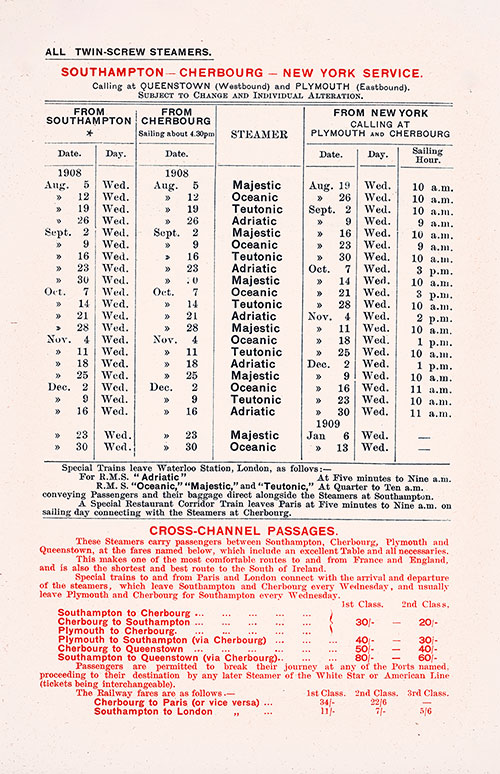
Sailing Schedule, Southampton-Cherbourg-New York Service, from 5 August 1908 to 13 January 1909. Ships Included the Adriatic, Majestic, Oceanic, and Teutonic. Information and Fares for Cross-Channel Passages is also Listed. SS Romanic Passenger List, 4 October 1908. | GGA Image ID # 1e57207633
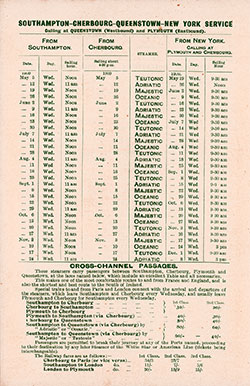
White Star Line Sailing Schedule, 5 May 1909 to 8 December 1909
The RMS Adriatic, operated by the White Star Line, was scheduled for transatlantic voyages between 5 May 1909 to 8 December 1909.
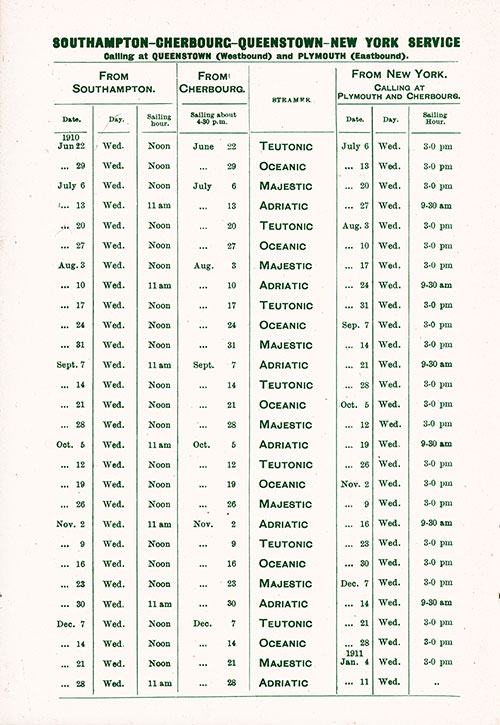
Sailing Schedule, Southampton-Cherbourg-Queenstown (Cobh)-New York Service, from 22 June 1910 to 11 January 1911. Ships Included the Adriatic, Majestic, Oceanic, and Teutonic. RMS Cymric Passenger List, 26 July 1910. | GGA Image ID # 1e560cb675
Sailing Schedule, Mediterranean Service, from 24 June 1911 to 15 July 1912. Ships Included the Adriatic, Canopic, Cedric, Cretic, and Romanic. SS Canopic First Class Passenger List, 23 July 1911. | GGA Image ID # 211f842956. Click to View Larger Image.
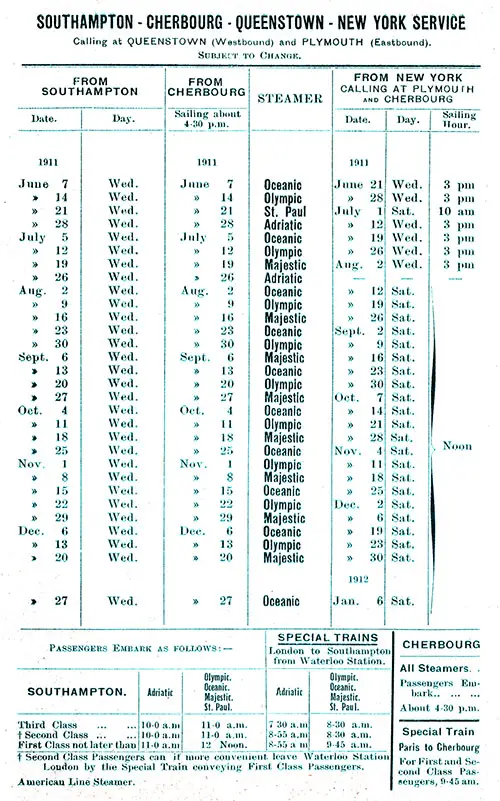
Sailing Schedule, Southampton-Cherbourg-Queenstown (Cobh)-New York, from 7 June 1911 to 6 January 1912. Ships Included the Adriatic, Majestic, Oceanic, Olympic, and St. Paul. SS Canopic First Class Passenger List, 23 July 1911. | GGA Image ID # 211f985a63
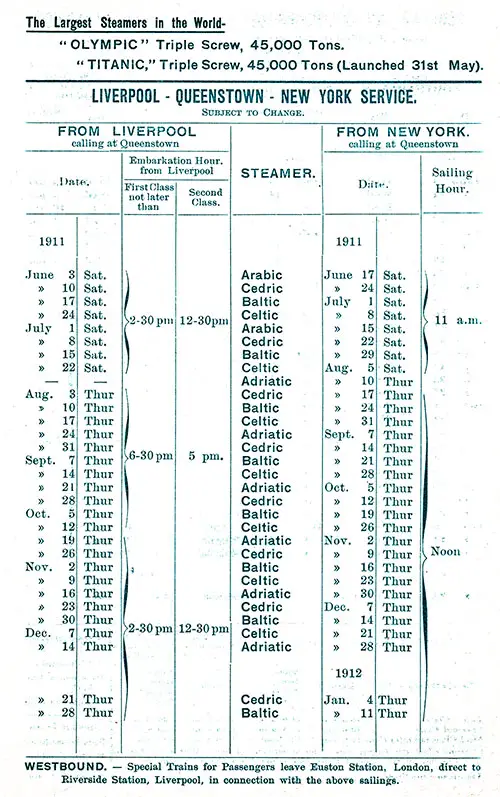
Sailing Schedule, Liverpool-Queenstown (Cobh)-New York, from 3 June 1911 to 11 January 1912. Ships Included the Adriatic, Arabic, Baltic, Cedric, and Celtic. SS Canopic First Class Passenger List, 23 July 1911. | GGA Image ID # 211fbbe1b8
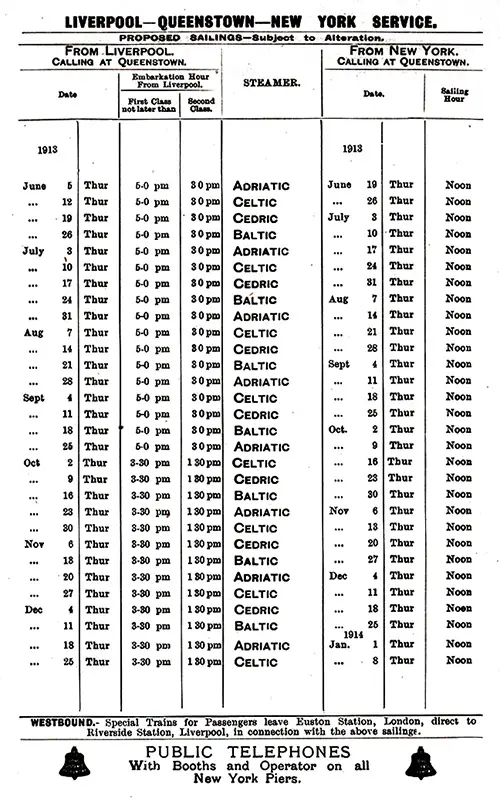
Sailing Schedule, Liverpool-Queenstown (Cobh)-New York Service, from 5 June 1913 to 8 January 1914. Ships Included the Adriatic, Baltic, Cedric, and Celtic. RMS Laurentic Passenger List, 24 June 1913. | GGA Image ID # 2084e6c859
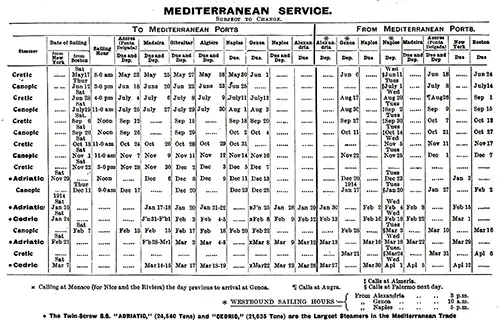
Sailing Schedule, Between New York-Boston-Mediterranean Ports, 17 May 1913 to 12 April 1914. Ships Included the Adriatic, Canopic, Cedric, and Cretic. RMS Laurentic Passenger List, 24 June 1913. | GGA Image ID # 20881ec2e3
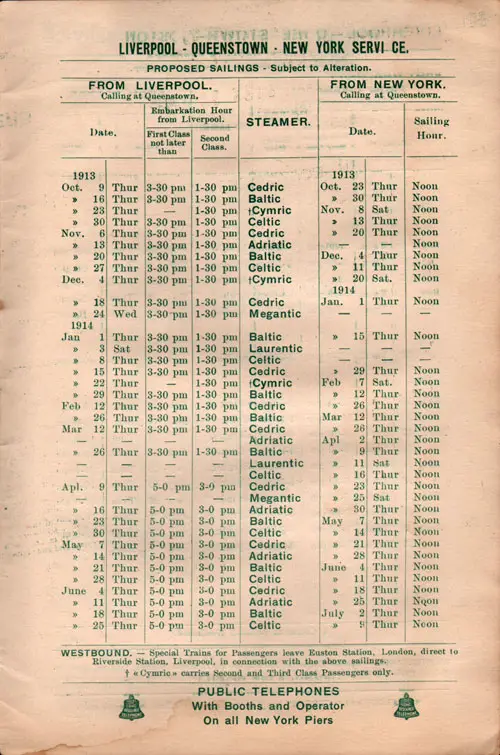
Sailing Schedule, Liverpool-Queenstown (Cobh)-New York Service, from 9 October 1913 to 9 July 1914. Ships Included the Adriatic, Baltic, Cedric, Celtic, Cymric, Laurentic, and Megantic. SS Cretic Passenger List, 22 November 1913. | GGA Image ID # 1e57d1734e
Sailing Schedule, White Star Line Mediterranean Service, from 13 October 1913 to 7 July 1914. Ships Included the Adriatic, Canopic, Celtic, and Cretic. SS Cretic Passenger List, 22 November 1913. | GGA Image ID # 1e57e4cab1. Click to View Larger Image.
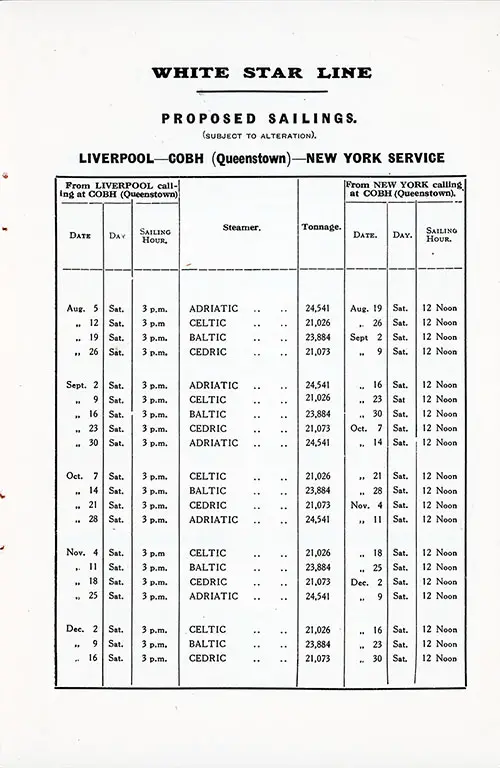
White Star Line Proposed Sailings, Liverpool-Cobh (Queenstown)-New York Service from 5 August 1922 to 30 December 1922. Ships Include the Adriatic, Baltic, Cedric, and Celtic. RMS Majestic Passenger List, 6 September 1922. | GGA Image ID # 1dd4bae80b
White Star Line Mediterranean Service Proposed Sailings from 29 August 1922 to 13 April 1923. Ships Included the Adriatic, Arabic, Cretic, and Lapland. Ports Included New York, Boston, Azores, Madeira, Gibraltar, Algiers, Monaco, Naples, Genoa, Alexandria, Haifa, Athens (Phaleron Bay), and Nice. RMS Majestic Passenger List, 6 September 1922. | GGA Image ID # 1dd525881f. Click to View Larger Image.
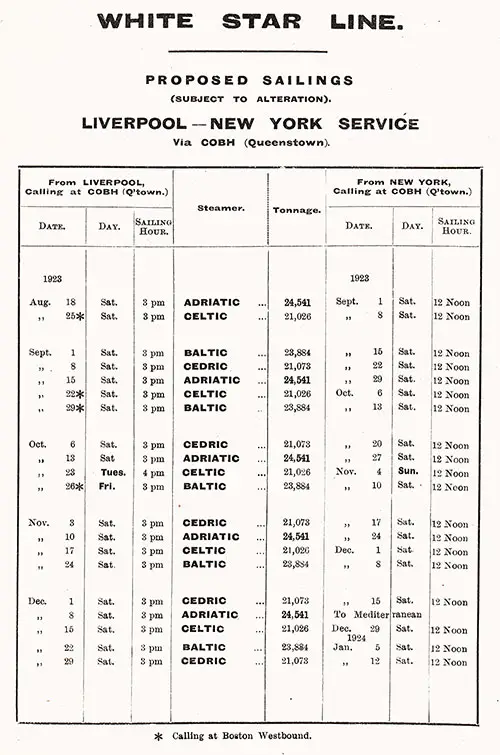
Sailing Schedule, Liverpool-Cobh (Queenstown)-New York, from 18 August 1923 to 12 January 1924. Ships Included the Adriatic, Baltic, Cedric, and Celtic. RMS Homeric Passenger List, 5 September 1923. | GGA Image ID # 1f0af1f041
Sailing Schedule, New York-Boston-Azores-Madeira-Gibraltar-Algiers-Monaco-Naples-Athens-Haifa-Genoa-Alexandria and Alexandria-Genoa-Naples-Azores-Boston-New York, from 20 October 1923 to 19 April 1924. Ships Included the Adriatic, Arabic, and Lapland. RMS Homeric Passenger List, 5 September 1923. | GGA Image ID # 1f0b758cbd. Click to View Larger Image.
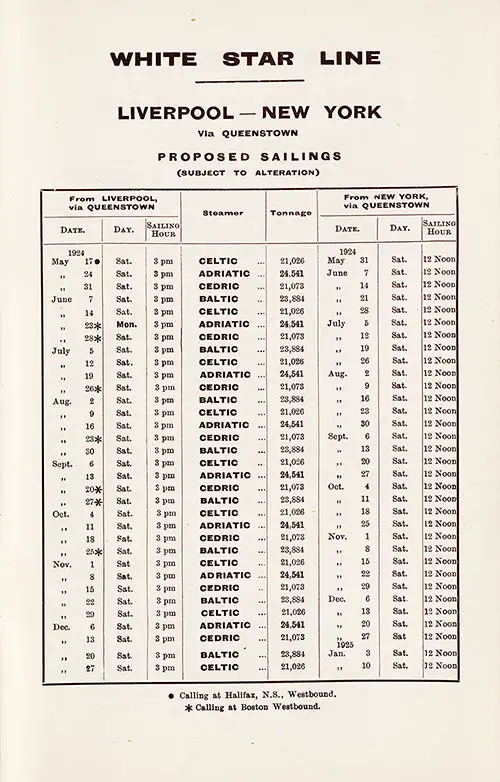
Sailing Schedule, Liverpool-Queenstown (Cobh)-New York, from 17 May 1924 to 10 January 1925. Ships Included the Adriatic, Baltic, Cedric, and Celtic. White Star Line RMS Olympic First Class Passenger List - 4 June 1924. | GGA Image ID # 207359171a
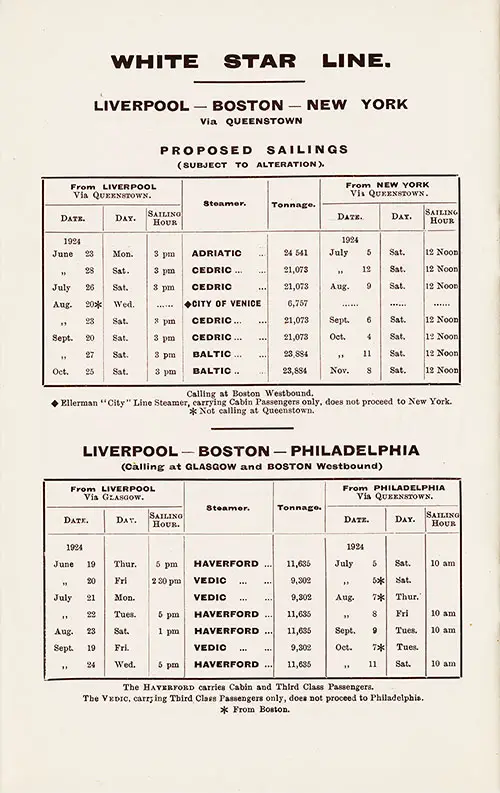
Sailing Schedule, Liverpool-Queenstown (Cobh)-Boston-New York, and Liverpool-Boston-Philadelphia, from 23 June 1924 to 8 November 1924. Ships Included the Adriatic, Baltic, Cedric, City of Venice, Haverford, and Vedic. White Star Line RMS Olympic First Class Passenger List - 4 June 1924. | GGA Image ID # 20735c2984
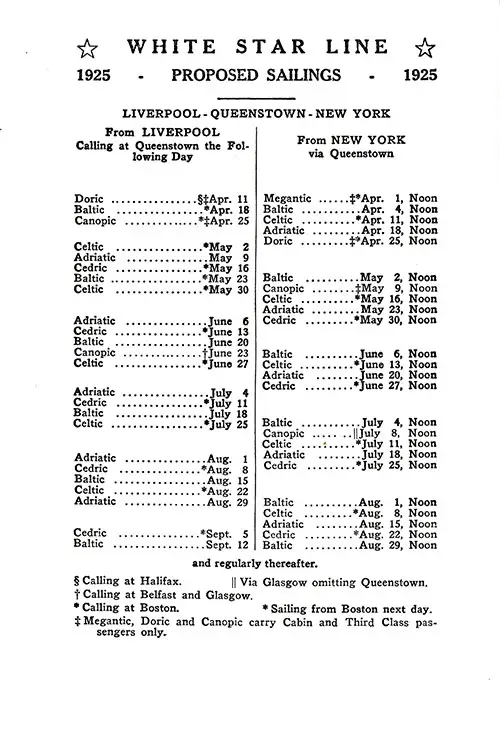
WSL Sailing Schedule, Liverpool-Queenstown (Cobh) New York and New York-Queenstown (Cobh)-Liverpool, from 1 April 1925 to 12 September 1925. Ships Included the Adriatic, Baltic, Canopic, Cedric, Celtic, Doric, and Megantic. SS Homeric Second Class Passenger List, 4 April 1925. | GGA Image ID # 20b6fe0f58
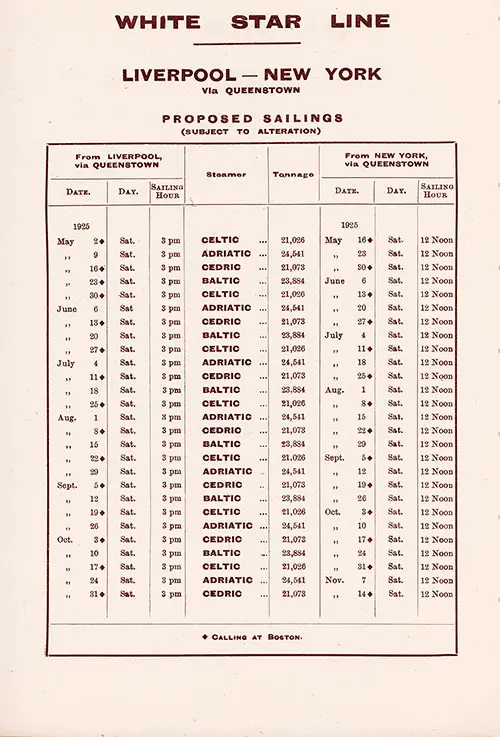
Sailing Schedule, White Star Line, Liverpool-New York via Queenstown (Cobh), from 2 May 1925 to 14 November 1925. Ships Included the Adriatic, Baltic, Cedric, and Celtic. RMS Celtic Passenger List, 30 May 1925. | GGA Image ID # 1e52582b7b
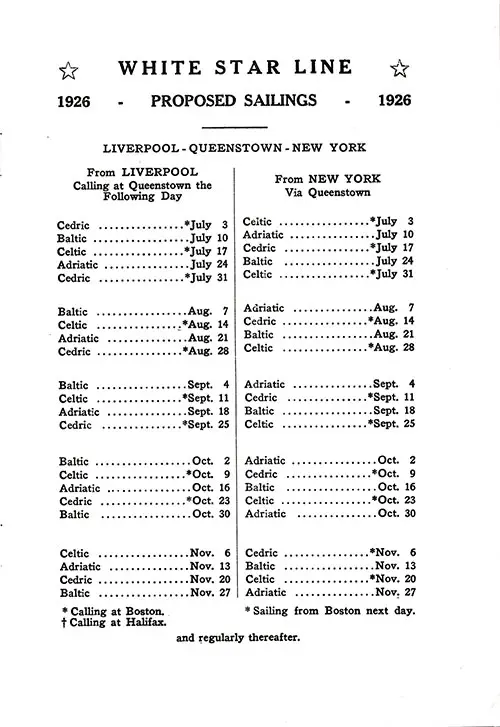
Proposed Sailings, White Star Line, Liverpool-Queenstown (Cobh)-New York, from 3 July 1926 to 27 November 1926. Ships Included the Adriatic, Baltic, Cedric, and Celtic. RMS Belgenland Passenger List, 26 June 1926. | GGA Image ID # 1df2408a0a
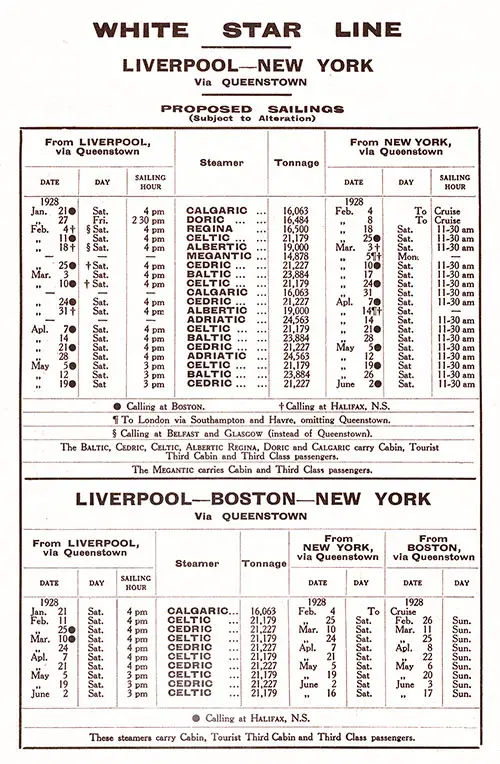
Sailing Schedule, Liverpool-Queenstown (Cobh)-New York and Liverpool-Queenstown (Cobh)-Boston-New York, from 21 January 1928 to 17 June 1928. Ships Included the Adriatic, Albertic, Baltic, Calgaric, Cedric, Celtic, Doric, Megantic, and Reginia. The Baltic, Cedric, Celtic, Albertic Regina, Doric, and Calgaric carry Cabin, Tourist Third Cabin, and Third Class passengers. The Megantic carries Cabin and Third Class passengers. RMS Baltic Cabin Class Passenger List, 3 March 1928. | GGA Image ID # 20c1e3cd08
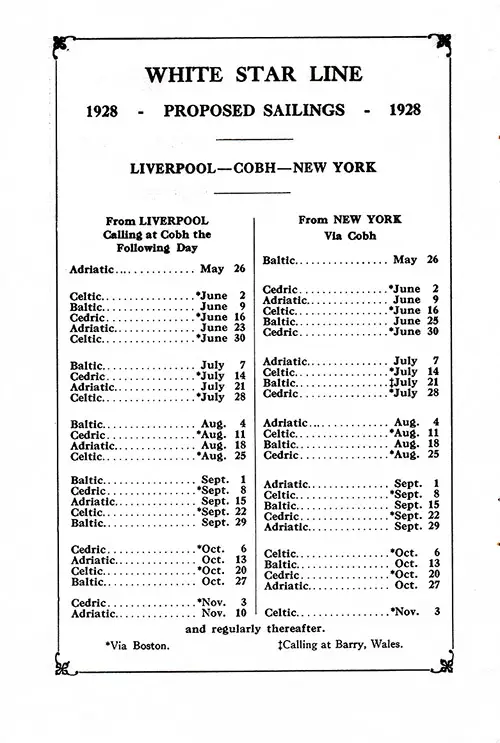
Sailing Schedule, Liverpool-Cobh-New York, from 26 May 1928 to 10 November 1928. Ships Included the Adriatic, Baltic, Cedric, and Celtic. SS Doric Passenger List, 19 May 1928. | GGA Image ID # 206d07db97
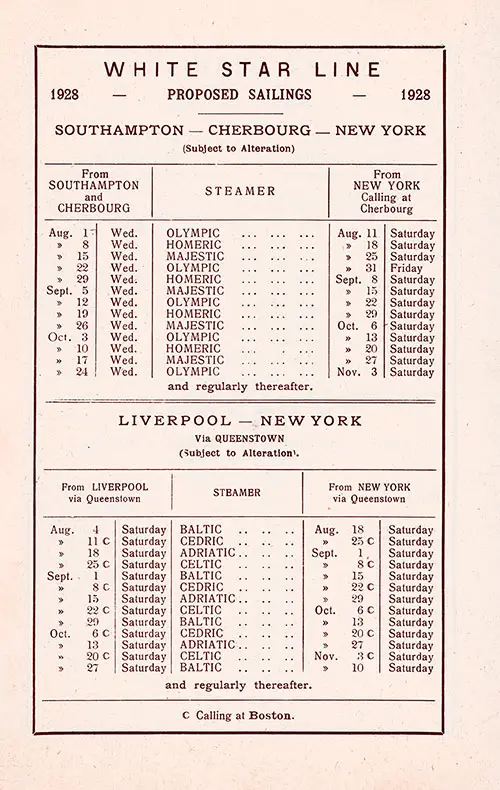
Sailing Schedule, Southampton-Cherbourg-New York and Liverpool-New York, from 1 August 1928 to 10 November 1928. Ships Included the Adriatic, Baltic, Cedric, Celtic, Homeric, Majestic, and Olympic. SS Lapland Passenger List, 31 August 1928. | GGA Image ID # 1ebe71055b
Return to Content Links
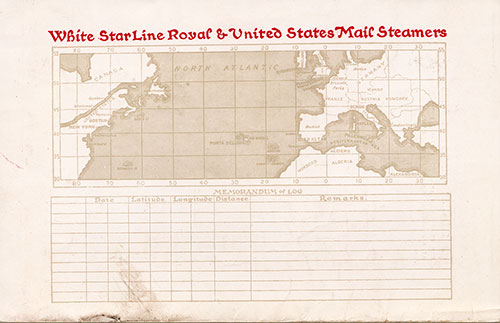
Track Chart and Memorandum of Log (Unused). RMS Adriatic Passenger List, 14 November 1919. | GGA Image ID # 1dd536122b
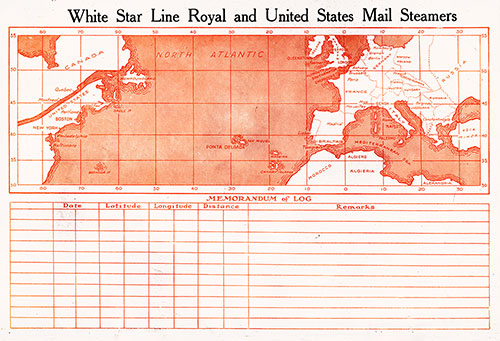
Track Chart and Memorandum of Log (Unused). RMS Adriatic Passenger List, 18 August 1923. | GGA Image ID # 1dd55d3fd1
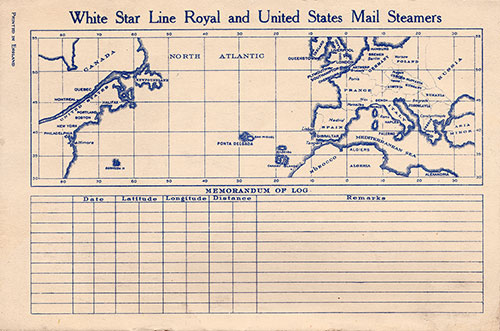
Track Chart and Memorandum of Log (Unused). Tourist Third Cabin Passenger List from the SS Adriatic, 8 February 1929. | GGA Image ID # 1dd5f91f63
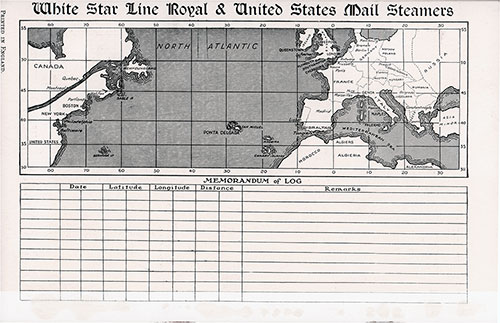
Track Chart and Memorandum of Log (Unused). RMS Adriatic Cabin Passenger List - 1 June 1929. | GGA Image ID # 12fae64bea

Track Chart and Memorandum of Log (Unused). RMS Adriatic Passenger List, 22 August 1931. | GGA Image ID # 1dd5f946e2
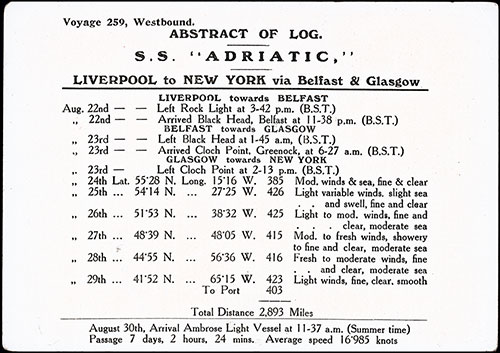
Abstract of Log, RMS Adriatic, Sailing from Liverpool to New York via Belfast and Glasgow, 22 August 1931. Passage: 7 Days, 2 Hours, 24 Minutes. Average Speed: 16.985 Knots. Includes Weather Encountered During Voyage. | GGA Image ID # 1d6323f22d
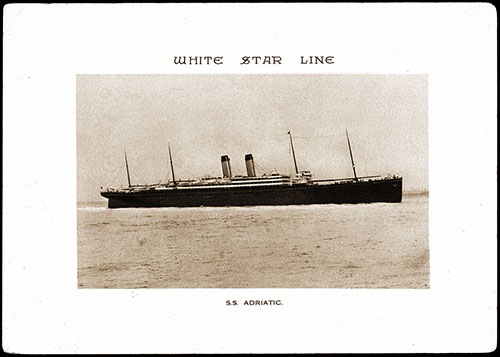
Photo of White Star Line Steamship SS Adriatic. 1931 Abstract of Log. | GGA Image ID # 1d6384dc56
The Abstract of Log for Voyage 259, Westbound, of the White Star Line SS Adriatic, Liverpool to New York via Belfast and Glasgow, covered 2,893 miles. The voyage took seven days, two hours, and 24 minutes for an average speed of 16.985 knots.
The latitude and longitude of the ship are taken at noon meridian and other regular periods as the captain may deem advisable. This, with the distance indicated by the speed indicator of the log at the stern, gives the data for the log book. Weather conditions are also noted, and an abstract from the log is printed and presented to passengers at the end of the voyage—a great souvenir for the passengers.
Return to Content Links
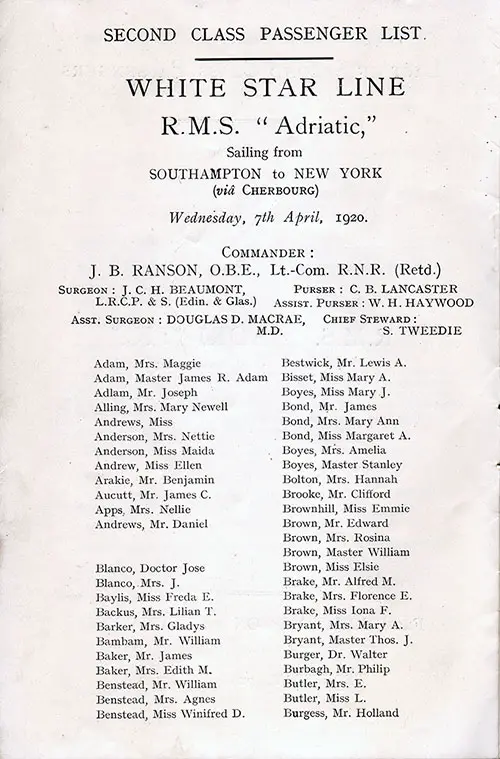
Passenger #29 AKA Mr. James Bond probably didn't raise an eyebrow in 1920. Did you know that passenger lists make a great source for naming fictional characters for writers? (Page 1 of Passengers - Third Name on Second Column is Bond, Mr. James). RMS Adriatic Passenger List, 7 April 1920. | GGA Image ID # 1dd53bd0d3
Carrying Concealed Weapons on the RMS Adriatic
A CABIN psssenger on the Adriatic, White Star Line, with the historical name of Smith, was arrested at Queenstown last month for having a revolver concealed on his person. This little imprudence cost him and mention is here made as a hint to " those about to sail for Europe."
Source: Ocean: Magazine of Travel, Vol. III, No. 2, September 1889, Page 42
Return to Content Links

A Century of Sea Travel: Personal Accounts from the Steamship Era
This book is a voyage through the life of the passenger steamship, a voyage described by travellers who sailed on these vessels, and it carries within it their thoughts and experiences, mirrored here in words and pictures.
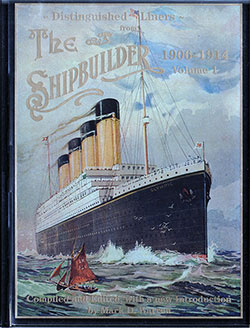
Distinguished Liners from The Shipbuilder - 1906-1914 Volume 1
An authentic replication to the smallest detail of the best of The Shipbuilder magazine, 1906-1914, including articles on the Titanic, Olympic, Lusitania, Mauretania, and more. This encyclopedic collection contains original text, photographs, and advertisements, as well as 22 fold-out blueprint plans, five color plates, a two-color Titanic cutaway folding advertisement and even two facsimile subscription forms.

Doomed Ships: Great Ocean Liner Disasters
Naval historian William H. Miller, Jr. recounts the dramatic stories behind various ill-fated passenger ships. He takes readers beyond the newspaper headlines and formal inquiries, offering firsthand accounts of heroic rescues, daring escapes, and tragic losses.

Great Passenger Ships of the World 1858-1912
This initial volume deals with Ships from 1858-1912, from the first passenger ship of over 10,000 GRT to be placed in service (the Great Eastern) to those unforgettable sister ships, the Olympic and Titanic — the first of more than 40,000 GRT.
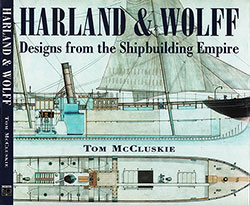
Harland & Wolff: Designs from the Shipbuilding Empire
The book is an introductory overview of the company, its shipyards, and its works is followed by 44 detailed drawings of the ships, from the earliest sailing vessels to the great liners such as the Canberra and the Southern Cross.
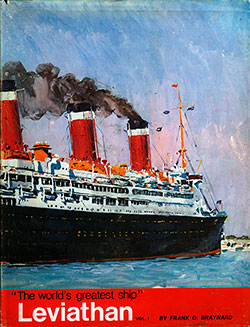
Leviathan: "The World's Greatest Ship" Volume 1
The first volume takes us from the construction of the VATERLAND to the end of World War One when the VATERLAND, now the U.S.S Leviathan, was used as a troop transport and packed with fabulous photographs and reproductions of newspaper articles.

Liverpool and the Mersey, Vol. 1: Gladstone Dock and the Great Liners
More than 190 rare archive photographs and maps, many never before published, recount the story of this most famous dock and the Great passenger Ships that were once a regular sight there.

Lost Liners, Titanic to the Andrea Doria
Maps, charts, and diagrams make this handsome volume a valuable reference tool and a compelling evocation of that glorious era when floating palaces ruled the sea lanes.

Majesty at Sea: The Four Stackers
The opulent and luxurious four-funnel passenger liners, of which only fourteen have ever been built, are unsurpassed in maritime history. Built between 1897 and 1921, these great vessels vied with each other in their standards of comfort, spaciousness, and speed, and great was the rivalry between their owners.

White Star Line - Merchant Fleets # 19
Despite the misfortunes of the White Star Line, it is still regarded with esteem and affection. For those born after the end of White Star, this vol. is, therefore, deliberately comprehensive and definitive. There is the usual chronological company history. Seventy-four scale profile drawings illustrate each of the 98 ships. The career history of each ship is given.

Morton Allan Directory of European Passenger Steamship Arrivals
This directory provides a ready means of ascertaining information that will be helpful, for it is arranged by year and steamship company, and there under by port of entry, the vessel name, its arrival date and port of embarkation.

Ocean Steamers: A History of Ocean-Going Passenger Steamships 1820-1970
A history of the steam-powered passenger ship that details its story from the SS Savannah of 1819 to the SS Hamburg of 1969. It contains historical details of all civilian vessels built in the intervening years, with numerous illustrations and previously unpublished material.

Pictorial Encyclopedia of Ocean Liners, 1860-1994
One of the most comprehensive pictorial references on ocean liners ever published, this superb chronicle by noted maritime historian William H. Miller, Jr., depicts and describes virtually every passenger ship of over 15,000 tons built between 1860 and the late 1900s.

Picture History of British Ocean Liners: 1900 to the Present
Over 200 rare black-and-white illustrations provide views of the ships at sea and in port, glimpses of lavish staterooms, lounges, dining areas, onboard photos of celebrities and royalty, and much more.

Picture History of the Cunard Line 1840 - 1990
The Picture History of the Cunard Line 1840 - 1990 has over 180 photographs and illustrations showing the liners on the high seas and in port and depicting handsome staterooms, lounges, interior decor, and carefree life aboard ship.
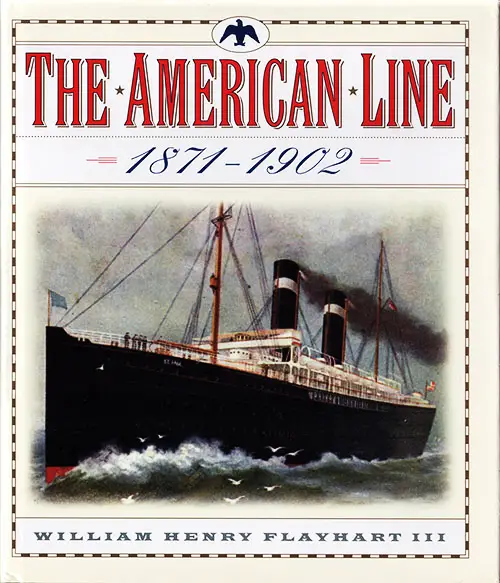
The American Line: 1871-1902 (2000)
📚 "Restoring the Stars and Stripes to the North Atlantic"
William H. Flayhart III’s The American Line: 1871–1902 is a powerful narrative chronicling one of the most ambitious yet underappreciated efforts in U.S. maritime history: the rebirth of American transatlantic shipping in the age of steam. For teachers, students, historians, genealogists, and lovers of ocean liner history, this book offers an indispensable resource on how the American Merchant Marine tried to reclaim its former glory after the Civil War devastated the industry.
The book centers around the rise of the American Line, backed by Philadelphia’s business elite and the Pennsylvania Railroad, and its close cousin, the Red Star Line, launched under a foreign flag to circumvent U.S. restrictions. Flayhart’s exhaustive research delivers a sweeping yet accessible account of how these two lines changed the face of transatlantic travel.
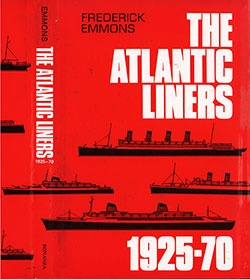
THE ATLANTIC LINERS will be cherished by all the millions of Americans who love the sea. Frederick Emmons sketches the histories of every ocean liner that sailed between the United States and Europe between 1925 and 1970.

The Blue Riband of the Atlantic
The blue riband of the Atlantic was the symbolic prize awarded to the luxury liner that made the fastest crossing of the Atlantic Ocean. This book begins with a description of the origins of ocean steamship travel and then discusses the development and careers of the most famous ships involved.

Tourist Third Cabin: Steamship Travel in the Interwar Years
Ocean Liners and New Vistas of Interwar Society From Immigrants to Tourists. The Changing Complexion of Translatlantic Passengers as The Soul of a Ship. Experience and Life of Below-Deck Personnel Traveling Palace or Floating Sweatshop. The Experience of Women Seafarers Projecting an Image: The Allure of Transatlantic Travel.
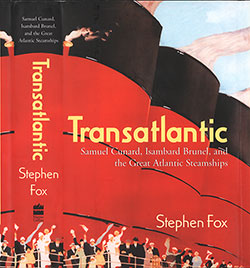
Transatlantic and the Great Atlantic Steamships
A stirring narrative of the rapid development of the great transatlantic steamships, from paddle-wheelers to the sleek luxury greyhounds of the modern era -- and the men who designed and ran them.
Return to Content Links
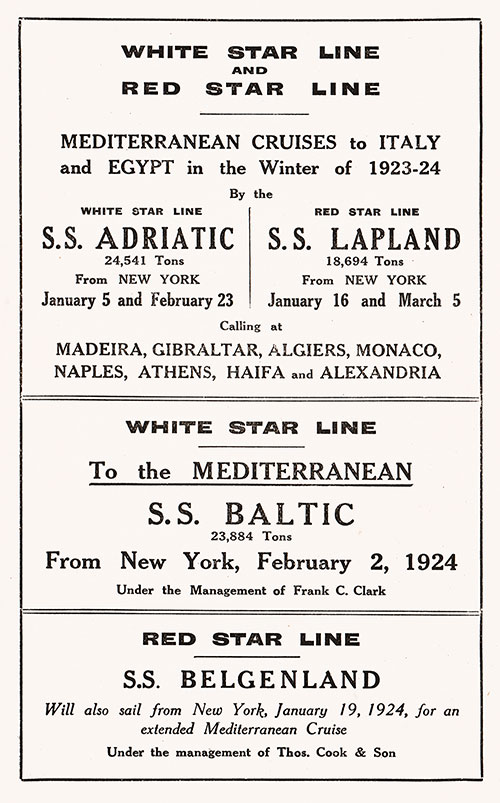
Mediterranean Cruises to Italy and Egypt in the Winter of 1923-1924 by the White Star Line SS Adriatic and Red Star Line SS Lapland. Frank C. Clark Tours to the Mediterranean on the White Star Line SS Baltic. Thomas Cook & Son Tours to the Mediterranean on the Red Star Line Belgenland. RMS Homeric Passenger List, 5 September 1923. | GGA Image ID # 1f09d5deba
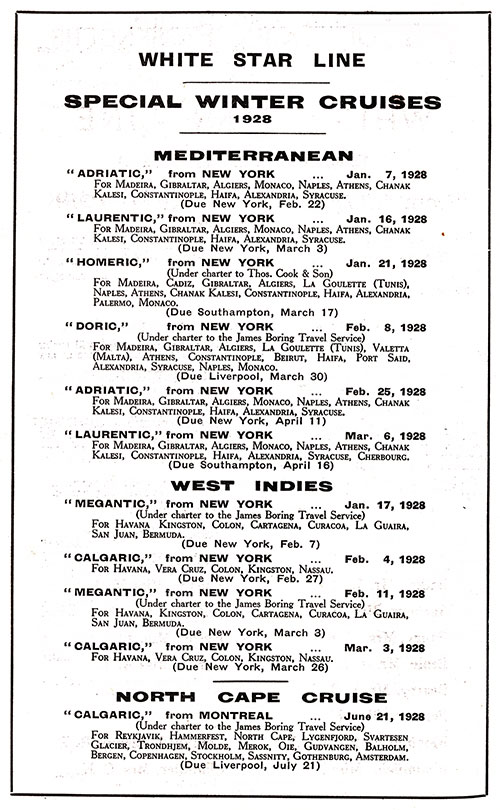
Advertisement: White Star Line Special Winter Cruises, 1928. Ships Included the Adriatic, Calgaric, Doric, Homeric, Laurentic, and Megantic. RMS Baltic Cabin Class Passenger List, 3 March 1928. | GGA Image ID # 20c06e3593
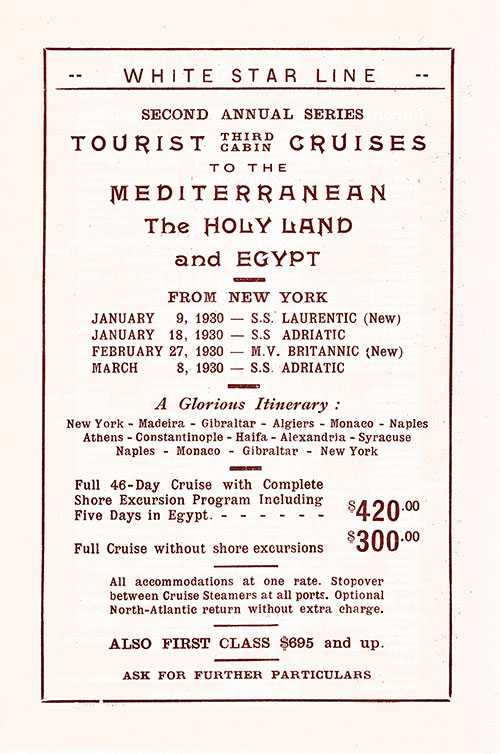
Advertisement: White Star Line Second Annual Series 1930, Tourist Third Cabin Cruises to the Mediterranean, The Holy Land, and Egypt. Ships Include the Adriatic, Britannic, and Laurentic. Departures from New York Starting 9 January 1930. Full 46-Day Cruise with Complete Shore Excursion Program Including Five Days in Egypt $420.00. Full Cruise Without Shore Excursions $300.00. First Class $695 and Up. RMS Arabic Passenger List, 16 August 1929. | GGA Image ID # 1e4ce3b698
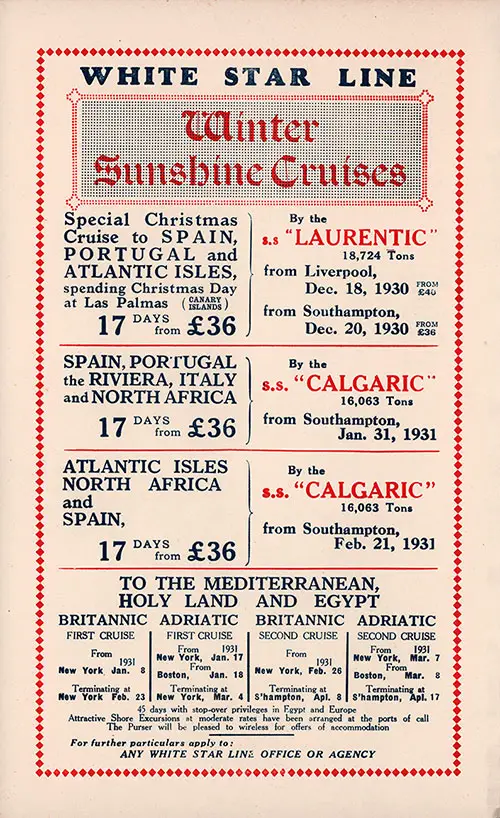
White Star Line Winter Sunshine Cruises for 1930-1931 by the SS Laurentic 18,724 Tons, SS Calgaric 16,063 Tons, and Cruises to the Mediterranean, Holy Land, and Egypt on the Adriatic or Britannic. RMS Homeric Passenger List, 6 August 1930. | GGA Image ID # 1f0fa05d2b
Return to Content Links
Information for Passengers - 16 June 1919
Breakfast. As the Bugle not sounded for breakfast, Passengers desirous of being wakened should arrange to be called by the Bedroom Steward.
SEATS AT TABLE. Passengers who have not previously arranged for seats at table to be reserved should apply for same to the Second Steward. Children are not entitled to seats in the Saloon unless full fare is paid.
NOTICE—First Class Passengers desiring to dine later than the usual hour, 7:00 pm, can have dinner served at any time up to 8:15 p. m. by giving notice to the Second Steward not later than 1:30 p. m.
AN ENQUIRY OFFICE has been provided for the convenience of Passengers, where all enquiries for Information of a general character should be made.
LETTERS, CABLES AND TELEGRAMS are received at the Enquiry Office for dispatch. and Postage Stamps can be purchased, and Deck Chairs hired at this office, through which also all Mails will be distributed. Cablegrams and Telegrams should be handed in an hour before the arrival at any port of call.
None of the ship's staff other than those on duty in the Enquiry Office, is authorized to accept Letters or Telegrams for dispatch.
DECK CHAIRS can be hired at a charge of $1.50 each for the voyage.
STEAMER RUGS can be hired at a charge of $1.50 each for the voyage.
THE SURGEON is authorized to make customary charges, subject in each Case to the approval of the Commander, for treating passengers at their request for any illness not originating on board the ship. In the case of sickness developed on board no charge will be made, and medicine will be provided free in all circumstances.
EXCHANGE OF MONEY. The Purser is prepared, for the convenience of passengers, to exchange a limited amount of English and American money, at rates which will be advised on application.
VALUABLES. The White Star Line has provided a safe in the office of the Purser. In which passengers may deposit money. Jewels, or ornaments for safe keeping. The Company will not be liable to passengers for the loss of money, Jewels, or ornaments by theft or otherwise, not so deposited.
Passengers Landing at Liverpool - (First Class)
When a Steamer lands passengers at Liverpool in the early morning, Breakfast will be served at the following hours :
WEEK DAYS
- April to September inclusive, 7 A. M.
- October to March inclusive, 8 A. M.
SUNDAYS
All the year round, 8 A. M.
The Steamers will be Berthed at the Landing Stage:
WEEK DAYS
- April to September inclusive, 7.30 A. M.
- October to March inclusive, 8.30 A. M.
SUNDAYS
All the year round, 8.30 A. M.
When the Steamer arrives at night, passengers will not be landed until the following morning, unless the vessel passes the Rook Lighthouse, Liverpool, before 7.30. p. m.
Passengers will please note that any landing after 8:00 pm, Summer or Winter, is entirely at their own option; if they prefer it, they can remain on board and after breakfast, which will be served at 8 o’clock on the following morning, land either by tender or in dock, as may be arranged.
SMOKING is strictly prohibited in any of the Staterooms. Library or Dining Saloon.
MEALS not permitted to be served In the Library.
DECK CHAIRS can be hired at a charge of $1.50 each.
STEAMER RUGS can be hired at a charge of $1.50 each.
SECOND CLASS PASSENGERS are not allowed in the First or Third Class quarters.
Source: RMS Adriatic Passenger List - 16 June 1919
Information for Passengers - 14 November 1919
The Bar opens at 8:00 am, and closes at 11:30 pm
Lights are extinguished in the Saloon at 11:00 pm, Lounge and Reading Room at 11:30 pm, and Smoking Room at 12 Midnight.
Divine Service in the Saloon on Sunday at 10:30 am
Notice. Passengers desiring to dine later than the usual hour, 7:00 pm. can have dinner served at any time up to 8:15 pm, by giving notice to the Second Steward not later than 1:30 pm.
Deck Chairs can be hired at a charge of 6/- each for the voyage. Steamer Rugs can be hired at a charge of 6/- each for the voyage.
Exchange of Money. The Purser is prepared, for the convenience of Passengers, to exchange a limited amount of English and American money, at rates which will be advised en application.
Travellers' Cheques, payable in all parts of Europe, can be purchased at all the principal Mikes of the White Star Line. These Cheques are accepted on board White Star steamers in payment of accounts, but the Pursers do not carry funds to enable them to cash same.
Dogs. Passengers are notified that dogs cannot be landed in Great Britain unless a license has previously been procured from the Board of Agriculture, London. Forms and License must be obtained by direct application to the Department before the dog is taken on board.
This Steamer is fitted with Marconi's system of Wireless Telegraphy and also with Submarine Signalling Apparatus.
Gymnasium. Adjacent to the Turkish and Electric Baths, There Is a Gymnasium, Which Will Be Open (With a Competent Attendant in Charge) For Exercise by Ladies and Gentlemen, Respectively, During the Same Hours as the Baths, but No Charge Will Be Made for the Use of the Appliances. Children—The Gymnasium Will Be Available for Children from 1:00 PM to 3:00 PM Only. Tickets Obtainable at the Enquiry Office
Upper Berths.
Passengers Occupying Upper Berths Can Obtain Steps for Getting in or Out of Same on Applying to the Steward or Stewardess.
Landing Arrangements at New York. Should the Steamer Arrive at the New York Wharf After 8:00 PM, Passengers May Land if They Wish to Do So and Have Their Baggage Passed by the Customs Authorities Immediately on Arrival. Still, Those Who Prefer to Remain on Board May Do So and Have the Whole of Their Baggage Passed the Following Morning Not Earlier Than __ O'Clock. Breakfast Will Be Served to Those Who Remain on Board Overnight.
Public Telephones. With Booths and Operators, on our New York Piers.
Source: RMS Adriatic Passenger List - 14 November 1919
Information for Passengers - 7 April 1920
BAGGAGE. Questions relating to Baggage should be referred to the Second Steward, who is the Ship’s Baggage Master. Trunks, Chairs, etc., which Passengers may desire to leave in charge of the Company, should be appropriately labeled and handed to the Baggage Master on the Wharf at New York, and such articles will be stored entirely at owner's risk. It is for passengers themselves to see all their Baggage is passed by the U.S. Customs Authorities on landing.
DECK CHAIRS can be hired at a charge of 7/6 each for the voyage.
STEAMER RUGS can be hired at a charge of 7/6 each for the voyage.
Source: RMS Adriatic Passenger List - 7 April 1920
Information for Passengers - 24 April 1920
Letters, Cables and Telegrams are received at the Enquiry Office for despatch, and Postage Stamps can be purchased and Deck Chairs hired at this office, through which also all Mails will be distributed. Cablegrams and Telegrams should be handed in an hour before the arrival at any port of call.
Passengers are requested to ask for a receipt on the Company's Form for any additional Passage Money, Chair Hire, or Freight paid on board.
Ocean Letters—The Marconi Company have inaugurated an "Ocean Letter" service, by which radio-telegrams may be sent from one ship to another going in an opposite direction, for delivery by Registered Post from the first port of call of the latter vessel. The rate is (inclusive of wireless, postage and registration) 5s. 6d. for 30 words plus Id. for each additional word up to a maximum of 100 words. This class of message must contain full Postal Address.
Cherbourg—Passengers are landed by tender up to 10 P. M., but if the Ship arrives later, they will disembark at 7:30 next morning.
Southampton—Passengers will be landed up to 10 P. M. If the Ship berths later, Passengers will disembark next morning at 8 o'clock, April to September inclusive (breakfast being served at 7:30 A. M.) or at 8:30 A. M., October to March inclusive (breakfast being served at 8 A. M.)
Turkish and Electric Baths On The S. S. 'Adriatic"
The Turkish Bath estblishment is located upon the main deck, consisting of the usual hot temperate and cooling rooms, shampooing rooms, plunge bath and massage couch. Electric Baths and a Plunge Bath are also provided in con. junction with same.
Experienced attendants are in charge. These Baths will be available for
- Ladies - From 10 A. M. to 1 P. M.
- Gentlemen From 2 P. M. to 7 P. M.
Tickets being obtainable from the Enquiry Office at a charge of 6/- ($1.25) each for the Turkish Baths and Electric Baths.
Plunge Baths
The Plunge Bath will be open between the following Hours:
- Ladies From 10:00 am to 11:30 am Free
`` 11 a_ m. to 1 p. rn. . 1/- - Gentlemen From 6:00 am to 9 a_ m. Free
`` 2:00 pm to 7:00 pm 1/-
Costume Provided Free of Charge.
Tickets Are Obtainable at the Enquiry Office.
Gymnasium
ADJACENT to the Turkish and Electric Baths there is a Gymnasium, which will be open (with a competent attendant in charge) for exercise by Ladies and Gentlemen, respectively, during the same hours as the Baths, but no charge will be made for the use of the appliances.
The Gymnasium will be available for Children from 1:00 pm to 3:00 pm only.
Deck Chairs can be hired at a charge of $1.50 each for the voyage.
Steamer Rugs can be hired at a charge of $1.50 each for the voyage.
Source: SS Adriatic Passenger List - 24 April 1920
Information for Passengers - 18 August 1923
The surgeon will be in attendance at the surgery for consultations at the following hours:— 10:00 am 6:00 pm 8:30 pm. The surgeon will be available at all times in cases of urgency.
Deck Chairs and Steamer Rugs can be hired on application at a charge of 6/6 each for the voyage.
Valuables. The particular attention of Passengers is drawn to the ticket conditions regarding the carriage and custody of articles specified in Section 4281 of the revised Statutes of the United States, but Passengers can and are accordingly advised to protect themselves by insurance. The Line has provided a safe in the office of the Purser in which Passengers may deposit money, jewels, ornaments, documents or other valuables for safe keeping and a deposit receipt will be issued by the Purser.
Deck Games and Amusements. Deck Quoits, Shuffleboard, Bull Board and other games are provided on deck under the charge of a Quartermaster.
Chess, Draughts, Dominoes, etc., may be obtained on application to Saloon Steward.
Picture Postcards. Picture Postcards of the steamer can be obtained gratis on application on board.
High Seas Mail.—On all British steamers British Postage Stamps and rates are used when mailing letters for European points, and such letters should be posted in the ship's letter box in the ordinary way.
The mail bag is closed a few hours previous to arrival. Full particulars can be obtained at the Enquiry Office upon application.
Wardrobe Trunks.
Passengers are advised that it is not always possible to arrange for the placing of Wardrobe Trunks in the passenger accommodation in a position where they are easily accessible, also that there is frequently difficulty with regard to the landing of such packages owing to their exceptional size. They are therefore recommended to use Steamer Trunks in preference.
Source: RMS Adriatic Passenger List - 18 August 1923
Information for Passengers - 8 February 1929
SEATS AT TABLE. Passengers who have not previously arranged for seats at table to be reserved should apply for same to the Second Steward.
When the steamers sail with full lists, children under the age of ten years not paying the adult fare are provided with meals at separate sittings in the Dining Saloon.
DECK CHAIRS AND STEAMER RUGS may be hired at the following rates :— each.
From New York to all ports to Naples and vice versa .. 7/6 or $ 1.90
New York to Alliens, Constantinople, Haifa, Alexandria and vice versa 10/- or $ 2.51
Madeira, Gibraltar or Algiers to Athens, or Alexandria............7/6 or $ 1.90
Between other ports .. .. .. .. .. .. 4/0 or $1.00
DECK CHAIR CUSHIONS. A limited supply of Cushions, with loose covers, for Deck Chairs is available for hire at charges Similar to those for Deck Chairs & Rugs.
PRECIOUS STONES or other similar articles of merchandise may not be taken as baggage, but all passengers must deliver such goods to the Purser of the vessel. The Pursers are instructed to furnish passengers with a receipt for merchandise so delivered and place the goods in the safes aboard their vessel until a Customs permit is presented to the Inspectors ordering the goods into the U.S. appraiser's stores for examination.
COTS. The steamers are supplied with a limited number of Cots for the use of infants. Application for same should be made to the Chief Steward.
DECK GAMES AND AMUSEMENTS. Deck Quoits, Shuffleboard, Bull Board, and other games are provided on deck under the charge of a Quartermaster.
Chess, Draughts. Dominoes, etc., can be obtained on application to the Public Room attendants.
PASSENGERS' QUARTERS. First Class passengers are not allowed to enter Tourist Third Cabin compartments, or vice versa, as complications might arise under the Quarantine Regulations.
BOOTS AND SHOES. These will be cleaned if left outside the Stateroom door.
LONG RANGE WIRELESS SERVICE. This vessel is fitted with special long range wireless apparatus which wil enable passengers lo communicate with their friends or business connections on shore at any time during the voyage across the North Atlantic Ocean.
Poste Radiotelegrams. Those messages are accepted for transmission to a selected vessel for mailing on arrival in port. This service provides a most economical channel of communication with friends and relatives on shore when full rate facilities are not desired.
SYRACUSE. All passengers and baggage will be landed at or embarked from the Molo della R. Capitaneria di Porto, (Central Custom House Zanagora Quay) Syracuse. Passengers landing with baggage will be subject to Customs Examination.
NAPLES. All passengers and baggage will be landed at or embarked from the Immacolatella Nuova, Naples. The Customs examination takes place at the Immacolatella Nuova.
MONACO. All passengers and baggage will be landed at or embarked from the Landing Quay, Monaco Harbour, by special tender. The Customs examination takes place at the Landing Quay.
GIBRALTAR. All passengers and baggage will be landed at or embarked from the Waterport wharf, Gibraltar, by special tender. Passengers landing with baggage will be subject to Customs Examination.
CINEMATOGRAPH PERFORMANCES. Cinematograph performances will be given in the Drawing Room as notified from time to time.
PHOTOGRAPHER. An expert photographer is carried by the steamer for the purpose of taking passengers' photographs and assisting them in their photographic work. For charges and appointments apply at the Enquiry Office or Barbers' Shops.
The "Adriatic" carries an Orchestra of skilled musicians which will play daily as follows in the First Class Companionway:—
- 11.0 am to 12:00 noon.
- 4.30 pm to 5.30 pm
- After Dinner.
DECK CHAIRS AND STEAMER RUGS may be hired at the following rates
- From New York to all ports to Naples and vice versa 7/6 or $ 1.90
- New York to Athens, Constantinople, Haifa Alexandria and vice versa 10/- or $2.50
- Madeira, Gibraltar or Algiers to Athens, or Alexandria 7/6 or $1.90
- Between other ports 4/- or $ 1.00
- From Alexandria to New York 8/-
- From Naples, Syrcause, Monaco or Gibraltar to New York . .6/6
- From Madeira, Gibraltar or Algiers to Athens, Haifa or Alexandria 6/6
- From Monaco or Naples to Alexandria, or vice versa 4/-
- Bctween other Mediterranean ports 2/6
VALUABLES. For the convenience ol passengers, the Line has provided, in the Purser's Office a safe in which money, jewels, ornaments, documents or other valuables may be deposited by passengers. A receipt for any articles so deposited will be issued by the Purser, but the Line does not, having regard to the ticket conditions and to the provisions of Section 502 of the Merchant Shipping Act, 1394. and of Section 4281 of the revised Statutes of the United Suites, accept any responsibility for the safe custody of any such articles. Passengers are accordingly advised to protect themselves by insurance.
PASSENGERS' QUARTERS. Tourist Third Cabin passengers are not allowed to enter First Clasr compartments, as complication might arise under the Quarantine Regulations.
The "Adriatic" carries an Orchestra of Professional musicians which will play regularly in the Tourist Lounge at the following times:—
- 10 to 11 and 3 to 4:00 pm
- 8 to 9:00 pm
Source: SS Adriatic Passenger List - 8 February 1929
Return to Content Links
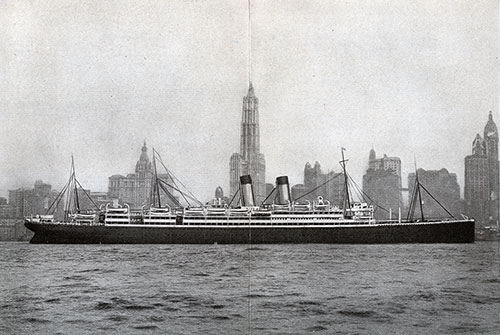
The Adriatic, Largest of the White Star Line's Big Four, Passing the Skyscrapers of New York City on Her Way to Sea. One of the Most Distinguished of Atlantic Liners, the Adriatic Is 24,541 Tons Register, 726 Feet Long and 75.5 Feet Wide. The Famous Big 4 of the New York-Liverpool Service, 1909 Brochure. | GGA Image ID # 11aaf24ce3
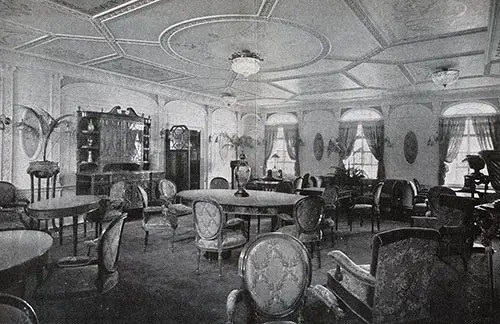
On Board the Big Adriatic the First Class Writing Room Is an Example of Harmony and Beauty in Design and Furnishings, Contributing to Restful Ease. the Large Windows Are Characteristic of the Writing Rooms on White Star Ships. the General Effect Strikes a Distinct Note of Elegance. The Famous Big 4 of the New York-Liverpool Service, 1909 Brochure. | GGA Image ID # 11ac59aa46
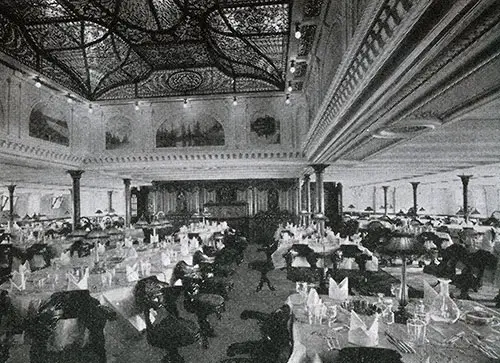
First Class Dining Saloon on the Adriatic. The Famous Big 4 of the New York-Liverpool Service, 1909 Brochure. | GGA Image ID # 11ace6508c
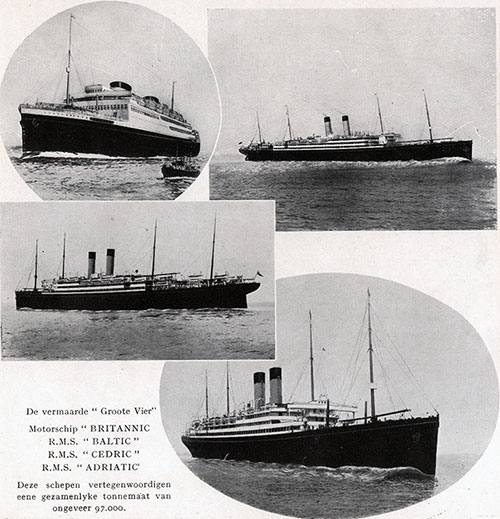
The Renowned "Big Four": MV Britannic, RMS Baltic, RMS Cedric, and RMS Adriatic -- These Vessels Represent a Combined Tonnage of Approximately 97,000. White Star Line To Boston and New York in the Third Class - 1930 Brochure. | GGA Image ID # 11eb3e77b0
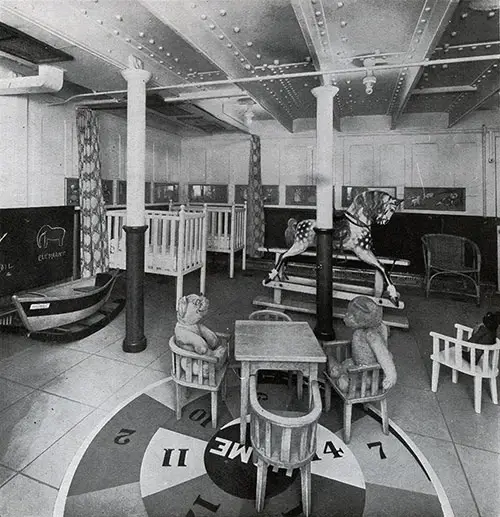
Third Class Children's Playroom on the RMS Adriatic. White Star Line To Boston and New York in the Third Class - 1930 Brochure. | GGA Image ID # 11ec11d6a4
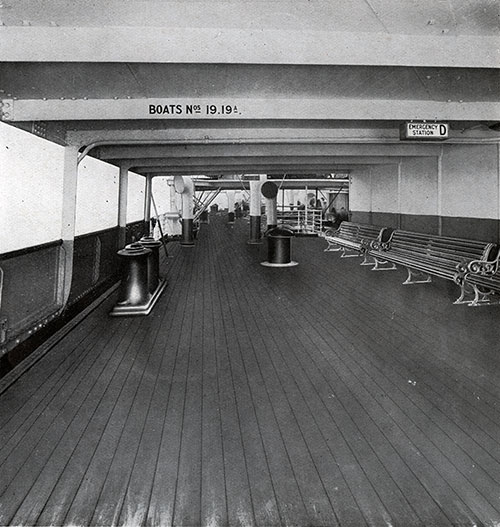
Third Class Deck Area on the RMS Adriatic. White Star Line To Boston and New York in the Third Class - 1930 Brochure. | GGA Image ID # 11ec40e96d
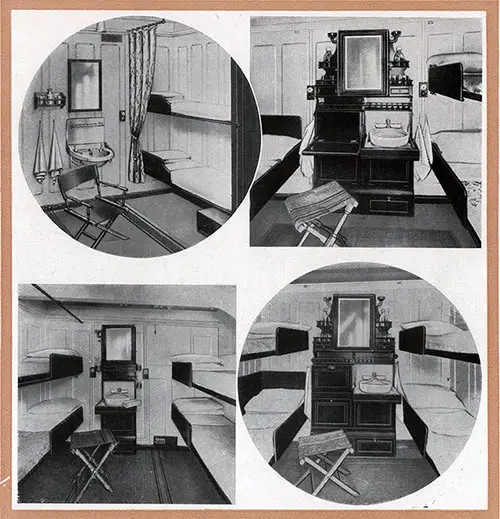
Third Class Staterooms (Clockwise from Top Left): MV Britannic Room with 2 Beds; RMS Baltic Room with 3 Beds; RMS Cedric Room with 4 Beds; And RMS Adriatic Room with 4 Beds. White Star Line To Boston and New York in the Third Class - 1930 Brochure. | GGA Image ID # 11ecd8e57d
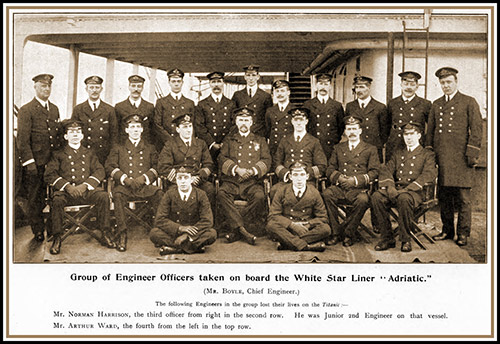
Group of Engineer Officers Taken on Board the White Star Liner RMS Adriatic. Mr. Boyle, Chief Engineer. The Following Engineers in the Group Lost Their Lives on the Titanic. Mr. Norman Harrison, the Third Officer from the Right in the Second Row. He was Junior Second Engineer on the Titanic. Mr. Arthur Ward, the Fourth from the Left in the Top Row. The Marine Engineer, May 1912. | GGA Image ID # 1f2380cb54
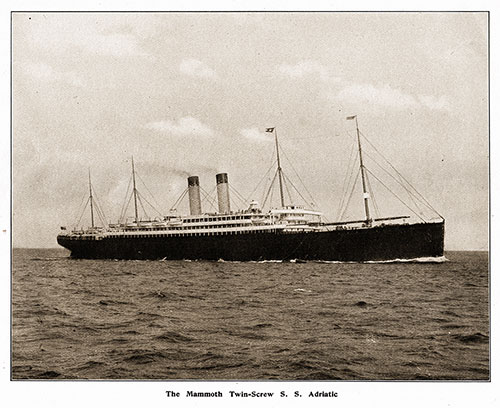
The Mammoth Twin-Screw SS Adriatic. Steamers of the White Star Line, 1909. From the Chris Crofts Collection. | GGA Image ID # 210f674615
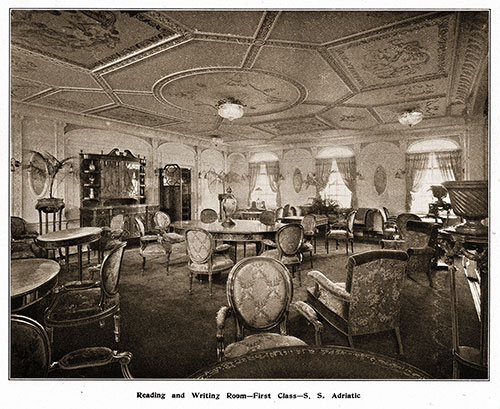
First Class Reading and Writing Room, SS Adriatic. Steamers of the White Star Line, 1909. From the Chris Crofts Collection. | GGA Image ID # 210f7424d9
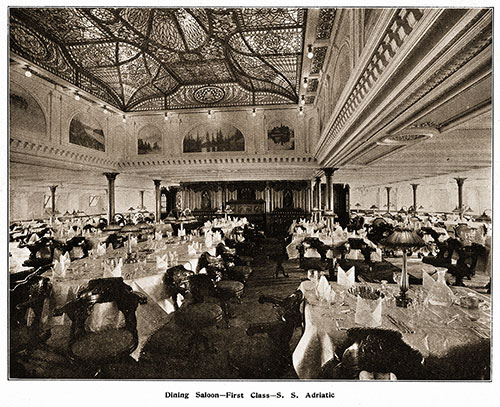
First Class Dining Saloon on the SS Adriatic. Steamers of the White Star Line, 1909. From the Chris Crofts Collection. | GGA Image ID # 210f8c718b
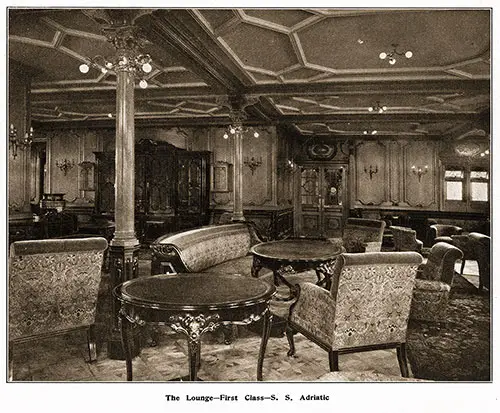
View of the First Class Lounge on the SS Adriatic. Steamers of the White Star Line, 1909. From the Chris Crofts Collection. | GGA Image ID # 210fa9aeb0
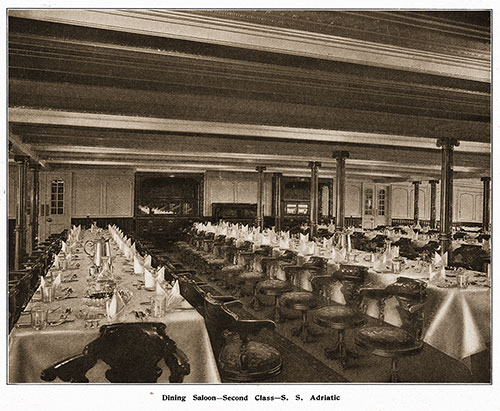
Second Class Dining Saloon on the SS Adriatic. Steamers of the White Star Line, 1909. From the Chris Crofts Collection. | GGA Image ID # 2116cd3944
Return to Content Links
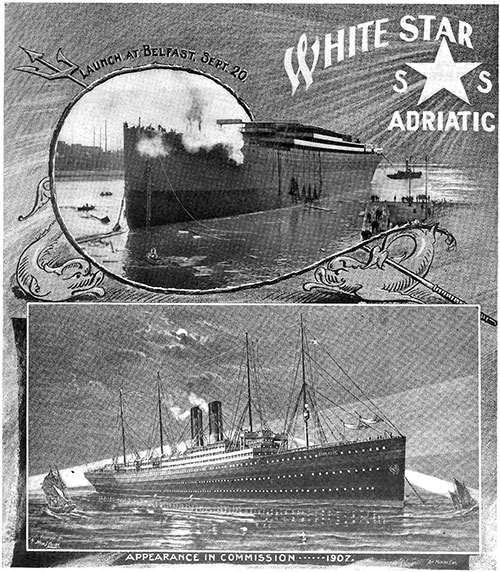
Front Cover of the White Star Line SS Adriatic Launch Brochure, 1906. | GGA Image ID # 1415035703
The new White Star Line leviathan Adriatic, built by Harland and Wolff, Belfast, Ireland, was successfully launched on September 20, 1906, in the presence of over 20,000 spectators.
For the people of Belfast, a launching ceremony may have lost its novelty, but on this occasion, an exceptional degree of local patriotism and the essentially human craving for a sensation combined to create an atmosphere of anticipation and excitement. This heightened sense of anticipation, it is said, focused public attention to a remarkable extent upon the launch, underscoring its historical significance.
Harland and Wolff, the renowned shipbuilders, once again etched their name in history with the construction of the Adriatic. Their contribution to the maritime industry was widely acknowledged, adding to the significance of the event.
Under these circumstances, small wonder that the people, not only of Belfast but of surrounding districts, and not a few from Liverpool, assembled to view the spectacle.
The importance of the event was further emphasized by the fact that the Queen's Island workmen were given a whole day's holiday. This is a concession without precedent at all events in the recent history of Harland and Wolff.
About 10,000 invitations had been issued, and even more than that number of people assembled in the yard, including a multitude of ladies, many of whom, in their anxiety to gain a good view of the launch, dared to scale the dizzy heights of several large vessels in the course of the construction in the vicinity.
The forenoon was observed as a half-holiday by most Belfast citizens, who thronged to the quays and piers on either side of the river, manifesting the most profound possible interest in the auspicious event.
The considerable gantry, which played a prominent part in the liner's construction, was gaily decorated with bunting, conspicuous being the national flags of America and England, while from a lofty mast amidships, the house flag of the White Star Line was floating.
The scene at the ways immediately before the launching was the usual one of many animations: hundreds of men were busily engaged in driving away with huge sleds the great blocks and other supports upon which the vessel rested.
The Launch of the Adriatic
The launch was fixed for quarter past eleven—the hour of high water—and almost on the stroke of time, the signal was given, 'All clear!' With precision and skill, at a word from the works manager (A. M. Carlisle), one of the foremen pulled the handle controlling the hydraulic launching machine, setting the Adriatic into motion.
Instantly, the grand Adriatic, a ponderous vessel weighing 16,780 tons-said to be the heaviest deadweight ever launched-started into motion. Sirens shrieked, and whistles sounded; there was a noise of creaking timbers and falling tackle, and amid the enthusiastic plaudits of thousands of sightseers, the stately Adriatic, with consummate grace and ease, glided down the slip into the waters beyond, leaving the audience in awe and admiration.
The gigantic hull, weighing 16,780 tons—said to be the heaviest deadweight ever launched—entered the river at almost twelve knots and was checked by cables and anchors attached to the bows in about half its own length. The whole operation took less than two minutes.
The Queen's Island firm has a reputation of never having experienced a hitch or accident of any kind at a launch, and at this function, the firm's tradition in this respect was worthily sustained.
Three powerful tugs were in waiting, and the new liner was conveyed to her fitting-up berth at Alexandra Pier, where she would receive her engines, boilers, and machinery and undergo the final stage of preparation for sea.
The interior work on the Adriatic is so well advanced that it is expected that in about four months, she will be ready for her trials and will begin sailing between Liverpool and New York early next year.
Beyond the fact that the builders had invited many guests to witness the launch, no formality attended the event. This was entirely by the custom of the White Star Line, regarding whose boats the christening ceremony, so frequent with other steamship companies, is always dispensed with.
Lord Pirrie, head of Harland and Wolff's, traveled from Dublin to attend the launch and entertained numerous guests.
Among the number was the Under Secretary for Ireland (Sir Antony MacDonnell), Lord Chief Baron Palles (Master of the Rolls for Ireland), Sir A. M. Porter, H. A. Sanderson, general manager of the White Star Line, Liverpool, Captain Murray, marine superintendent, White Star Line, and others.
After lunch, Lord and Lady Pirrie entertained the distinguished visitors at a private luncheon at Ormiston. A general description of the Adriatic was given in last month's issue, to which may be added the fact that she will be the largest vessel afloat propelled by reciprocating engines.
Some idea of the vastness of the Harland and Wolff establishment may be gained considering that last year, their output, exclusive of admiralty contracts for engineering, amounted to an aggregate gross tonnage of 85,287.
The vessels launched during the year included the Hamburg-American Company's magnificent liner Amerika, 22,723 tons; the Herefordshire, 7,183 tons; the Mahronda, Malakand, and Manipur, each over 7,600 tons; and the Holland-Amerika Company's Nieuw Amsterdam, 17,250 tons.
Adriatic Successfully Launched: A Magnificent Cargo and Passenger Steamer, in The American Marine Engineer, Chicago-New York, Vol. 1, No. 10, October 1906, p. 1-2.
Return to Content Links
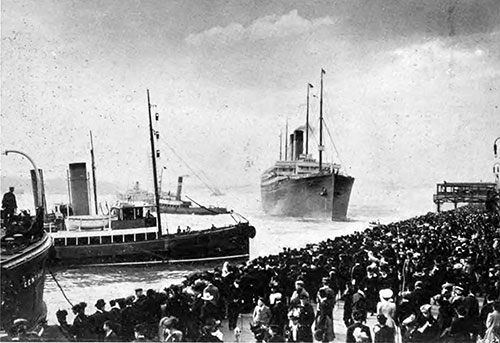
The RMS Adriatic Makes Its First and Last Trip from Liverpool. The White Star Liner "Adriatic" sialed on her maiden voyage from Prince's Landing Stage, Liverpool, at 5 pm on Wednesday, 15 May 1907 for New York. She is the largest twin-screw steamer affloat, and returns to Southampton to inaugurate the new White Star service commencing on 5 June 1907. | GGA Image ID # 141b11cd88
The Adriatic, a product of the unceasing enterprise of the White Star Line, is a state-of-the-art vessel that represents the highest attainment of the shipbuilder's art. Her impressive size has been ingeniously utilized to provide both safety and comfort, promising an exciting and intriguing journey for all our passengers.
The Adriatic, designed and constructed on absolutely safe lines, is a testament to the highest technical knowledge and previous experience. But it's not just about safety and experience. The Adriatic also represents the latest advancements in maritime technology. From its state-of-the-art propulsion system to its advanced communication and navigation equipment, the Adriatic is a perfect instrument in the development of international intercourse and commerce between the two great hemispheres.
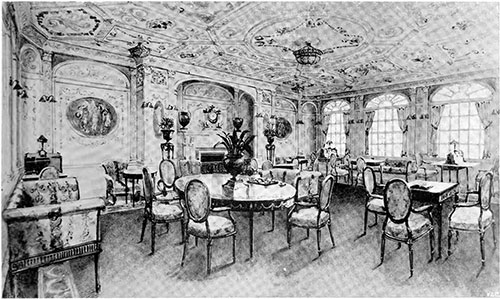
The First Class Reading Room. | GGA Image ID # 14192aa5ba
As the Adriatic confidently sails across the Atlantic at an impressive speed, it promises to be, in nautical terms, 'as steady as a rock' under all conditions. Rest assured, the ship's exceptional sea-faring capabilities and the luxurious comfort of its appointments elevate the joys of ocean travel, ensuring a truly indulgent experience for our esteemed guests.
The other leviathans of the White Star Line, such as the Oceanic, Celtic, Cedric, and Baltic, have become so popular that it is almost impossible to imagine the Adriatic could excel them. However, the managers of the line, in their constant endeavor to add to the attractiveness of their vessels and minister to the comfort of ocean travelers, have introduced a number of new features exclusively for the Adriatic.
These include a gymnasium, with the usual mechanical apparatus; an electric lift, running from the first-class entrance on the boat deck to the dining saloon on the upper deck, the lift thus serving four decks—viz., upper deck, promenade deck, upper promenade deck, and boat deck.
The dining experience on the Adriatic is a testament to luxury. The first-class dining saloon is designed in the popular restaurant style, with small tables scattered throughout the room, offering an intimate and elegant setting for our guests.
Prepare to be dazzled by the dining saloon, one of the most magnificent on the Atlantic. It's not just the opulent setting that will captivate you, but also the live music. The owners have arranged to carry an orchestra on the new vessel, a feature in English steamers that is sure to be greatly appreciated.
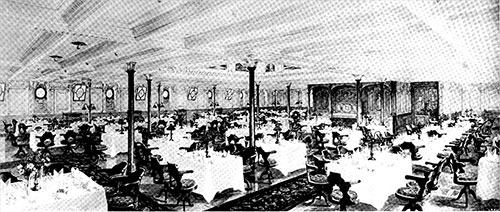
The First Class Dining Saloon. | GGA Image ID # 14198677b0
The most notable innovation, however, is the provision of Turkish baths on this ship. Since the revival of the bath of antiquity and its introduction into this country under the name of the Turkish bath, probably nothing more exciting or significant has occurred than its application for the first time to the needs of ocean travelers, a fact that in itself is sufficient to make the Adriatic the most popular vessel on the Atlantic.
The Turkish baths on this ship consist of the usual hot, temperate, and cooling rooms, shampooing rooms, plunge baths, and massage couches. Electric baths are also provided. The Adriatic is 725 ft. 9 in. long, 75 ft. 6 in. beam, and about 50 ft. deep. Its gross tonnage is nearly 25,000 tons, and its displacement is over 40,000 tons.
The double bottom extending the ship's entire length is a unique safety element. The Adriatic has nine steel decks and is divided into twelve water-tight compartments.
The total number of steel plates used in the hull construction is nearly 20,000, and the rivets are estimated at almost 2,500,000. The cables are 3 3/8 in. diameter and weigh about 90 tons; the anchors weigh about 8 tons each.
The general arrangements of the ship are similar to those of the Baltic and other vessels of this type. A continuous shade deck runs fore and aft, with three tiers of deckhouses and three promenade decks above them. On the boat deck are the first-class lounge, reading and writing room, and smoke room.
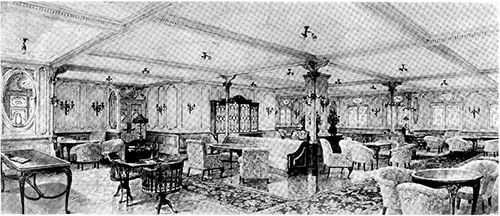
The First Class Lounge. | GGA Image ID # 1419bae97c
The large deck staterooms are arranged on the upper and promenade decks, which form an essential feature and are much admired in the first-class accommodation of the Celtic, Cedric, and Baltic. A further attraction is many single-berth rooms, which the traveling public will appreciate.
The first-class dining saloon is on the upper deck, and all the first-class accommodation is arranged amidships. Immediately above the first-class is the second-class accommodation, which includes a comfortable dining saloon with nearly 300 seats, a smoke room, and a ladies’ room for this class of passengers.
The second-class saloon is an exceptionally fine room extending the entire width of the ship. Third-class passengers are provided for abaft the second class and to a limited extent at the fore end of the vessel.
A great feature of this accommodation is the large number of two-, three-, and four-berth cabins and the spacious and comfortable dining rooms with tables and revolving chairs. A visitor to the Adriatic cannot fail to be impressed with the strength, luxury, and roominess that are everywhere apparent.
The amount of "headroom" is, perhaps, the most striking: The strength and luxury may be taken for granted in a White Star liner, but the size of the entrances, apartments, etc., as well as the spaciousness of the promenades, must be seen to be appreciated.
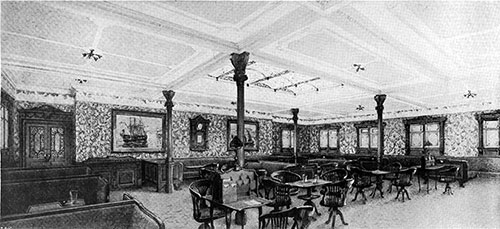
First Class Smoking Room. | GGA Image ID # 1419e52863
The staterooms are lofty, well-lighted, well-ventilated apartments, while the bed furniture, lounges, wardrobes, and toilet equipment are excellent. The enormous beam of the vessel and the height between the various decks or floors have made it possible to provide rooms of exceptional size. The decoration of the multiple staterooms is well in keeping with the traditions of the White Star Line.
Of course, the most luxurious style is seen in the accommodation for first-class passengers, for whom many separate and distinct suites of apartments are provided, consisting of a stateroom, sitting room, bathroom, etc.
These rooms have extra wide beds, writing tables, and wardrobes upholstered in blue moquette. The decoration consists of tiny white paneling; the ceiling incrusts are all white. The other first-class rooms are similarly decorated and upholstered.
The first-class entrances are paneled in oak, with ceilings of unique design flat white, and the first-class passages have polished oak dado, with white paneling above. However, the principal feature in the decorations is the treatment of the chief public rooms in the vessel, viz., the grand first-class dining saloon, the reading and writing room, the lounge, and the smoking room.
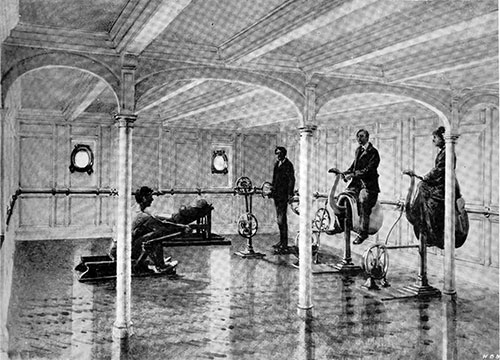
First Class Passengers Taking Advantage of the Gymnasium. | GGA Image ID # 1419fe6a1a
The accompanying illustrations give some idea of the style of decoration and furnishing of these rooms. It will be seen that "over-elaboration," so frequent in ship decoration, has been carefully avoided. At the same time, each apartment has a quiet but rich and symmetrical beauty that is very restful and pleasing to the eye.
The first-class dining saloon is a very handsome apartment. As mentioned, it is situated on the upper deck and extends the entire ship's width. It is exceptionally lofty and airy and contains seating for about 370 people.
It is paneled in the stately fashion of Charles II. and painted cleanly and simply with a delicate and ivorylike white; the gold, a time-honored adornment of other saloons, is strictly confined to the metal fittings here.
Over the middle of the room is a dome filled with leaded glass, white and the palest yellow. Under it are paintings of scenes in Switzerland and Italy, the Yellowstone and the Rhine, to remind the diners of happy hours spent in these playgrounds of the world.
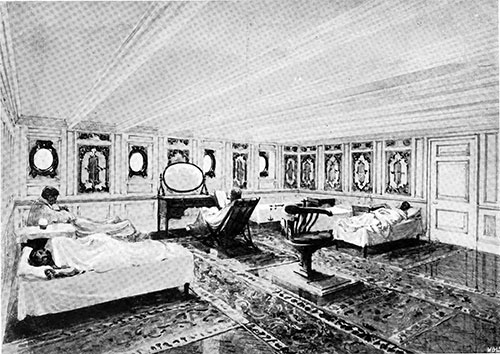
First Class Passengers Relaxing in the Turkish Bath. | GGA Image ID # 141a3c2c1e
The saloon offers a unique opportunity for music with a grand piano. Its case is adorned with charming and graceful figures inlaid in light woods on the oak it is composed, adding a touch of elegance to the space. The tables, arranged in the popular restaurant style, are another unique feature, replacing the old-fashioned long straight rows.
This new arrangement, the artistic and practical decoration of the lovely domed skylight, and the addition of the orchestra provided for in this steamer will make this a perfectly ideal saloon.
The comfort and convenience of our esteemed passengers are of utmost importance. To enhance their journey, a special arrangement of portholes allows them to enjoy the advantages of the fresh sea air without being subjected to draughts. On the boat deck, a reading and writing room awaits, providing a serene space for intellectual pursuits.
As Kipling has told us in his familiar verses, "The liner, she’s a lady." In this room, this picturesque fact is made very clearly apparent. Here, we have a charming apartment, which the Adams Brothers might have provided for the comfort and delight of a lady on land.
We must remember that the sea is outside and all around us. The windows, as spacious as in an ordinary house, are filled with leaded glass. Glancing around them, we almost expect to see a cheerful park expanse. Still, we may comfort ourselves for that disappointment by stretching our limbs on luxurious chairs or settees around a very homelike fireside.
Here, we may read our books and write our letters. If our eyes wander around the room, we see the walls decorated in Adams fashion, with delicate ornaments in low relief, enclosing oval panels filled with paintings of the airy and graceful kind that Bartolozzi and Cipriani made familiar to our great-grandmothers.
The boat deck also houses a reading and writing room, a haven for intellectual pursuits. Shaded lamps on the walls and ceiling provide efficient yet not glaring light, creating a serene atmosphere. The elegant furniture, inlaid with birch, is a treat for the refined observer. The lounge, dedicated to the cult of the idler, offers a comfortable space for relaxation.
The oak paneling of the apartment is restful to his eye, and the ceiling paneling is well worthy of notice. An extensive and well-selected library invites him to recreation or study. Elegant writing tables allow him to finish his correspondence and, by their convenience, assuage the agonies of composition.
That done, he may turn with a sigh of relief to the comfortable sofas with which the room is amply furnished and may observe the work tables which are provided for the industrious, the cozy corners for intimate conversation, and the card tables for those to whom bridge appeals with irresistible allurement.
From the windows, these pursuits are blessed for our lounger by the presence in stained glass effigies of poets, painters, dramatists, and philosophers—great men who have done so much for him in the past. And when we say "him," we mean "her" too.
In the smoke room (also on this deck), cozy comfort is the keynote of the decoration and furnishing. The walls are hung with stamped leather and adorned with pictures that recall some stirring episodes in English naval history.
The seats are deep and luxuriously upholstered, of a kind to invite the smoker to the lazy enjoyment of his pipe, his glass, and his game. The rich and mellow tone of the stained glass windows affords a light in which the mahogany seats, with their carving and their brown leather coverings, fairly glow with a somber magnificence of coloring.
There is, of course, a barber's shop in the first-class accommodation, fitted up in the usual luxurious style, and the inquiry office is an attractive and valuable apartment at the main entrance on the promenade deck.
The second-class staterooms are decorated with white paneling, and the first and second-class rooms have Brussels carpets. The second-class smoke room is framed in oak with oak panels and a drapery design. It is upholstered in leather, and the furniture and dado are walnut.
The second-class ladies' room is satinwood with panels inlaid, furniture, and dado, mahogany. This room and the second-class smoke room have stained glass shutters, ceiling incrusts, and parquetry floors. The second-class saloon is white and gold, with mahogany furniture and an incrusted ceiling. Both the ladies’ room and saloon are upholstered in moquette.
The second-class lounge is paneled in oak, with oak furniture, easy tub chairs, etc. The second-class entrances are in oak and white. All first—and second-class staircases are made of oak. The third-class dining and smoking rooms are comfortable apartments with white framing and teak dado. A feature in these rooms is the revolving chairs.
Thus, the Adriatic ship, a vessel of unparalleled grandeur and exclusivity, offers accommodation for the 3,000 fortunate souls who will make up the complete list of human beings on board. With such a sizeable cargo-carrying capacity, the Adriatic is fitted with winches and other loading and discharging arrangements of the latest and most efficient type, ensuring a journey of utmost comfort and luxury.
Large refrigerating chambers are provided for the carriage of chilled beef, and the machines for working them are on the CO2 principle. An electric winch is specially provided for the rapid and noiseless handling of baggage and stores.
A Marconi house with apparatus is fitted on the boat deck aft, and the ship is also fitted with a submarine signaling apparatus. This means that the ship's navigators can become aware in foggy weather of their proximity to similarly fitted lightships in narrow waters, thus ensuring a correct course is kept.
The engines of this magnificent vessel are not the least exciting item. They consist of two sets of the quadruple-expansion type arranged on the "balanced" principle, which has successfully eliminated vibration.
The engine spaces, however, and those who work in them are isolated from the passenger quarters so that to the ordinary passenger, the only evidence of the mighty power that drives the vessel will be the smoke issuing from the funnels.
On the Adriatic ship, efficiency and advanced technology are the hallmarks. In addition to the propelling machinery, there is an enormous amount of auxiliary machinery—the steering engines, the electric light machinery, the refrigerating machinery, and the deck machinery—all of which are necessary to the efficient working of the vessel and are of the latest and most approved type, a testament to our commitment to excellence in maritime technology.
“The Ship of the Year: The White Star Liner Adriatic,” in The Syren and Shipping Illustrated, Vol. XLII, No. 540, London, 2 January 1907, p. 47-52
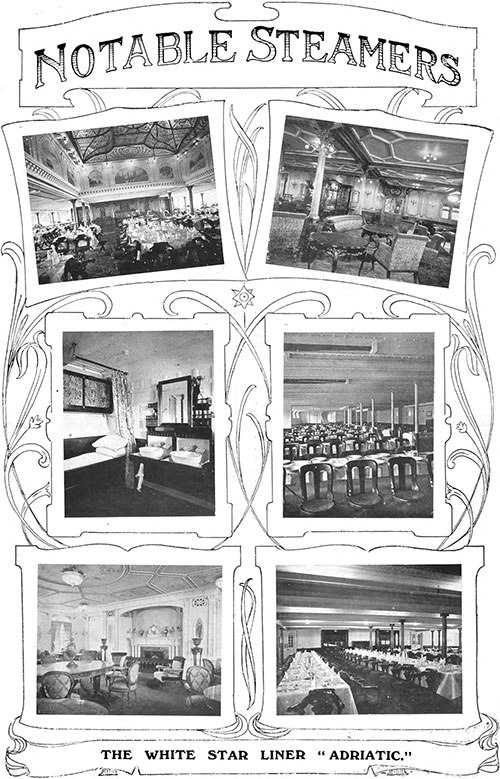
Notable Steamers of 1907 - The White Star Liner "Adriatic." (Left to Right, Top to Bottom): First Class Restaurant; First Class Lounge; First Class Stateroom; Third Class Dining Room; First lass Reading and Writing Room; and Second Class Dining Saloon. | GGA Image ID # 141b4e2ab5
Return to Content Links

